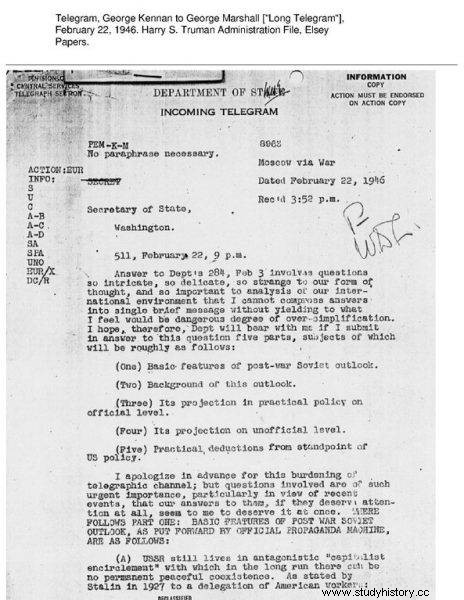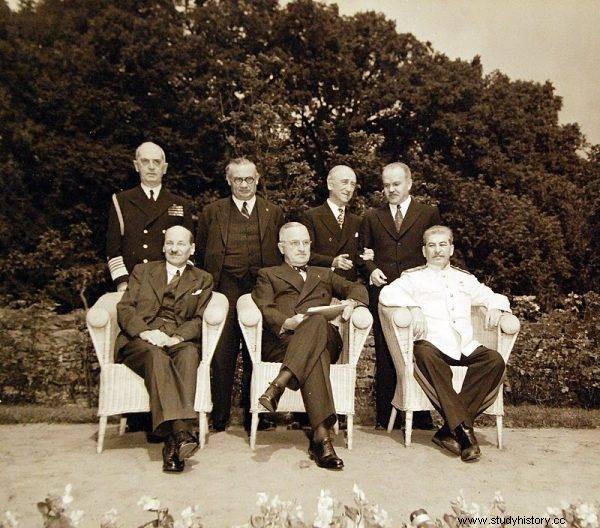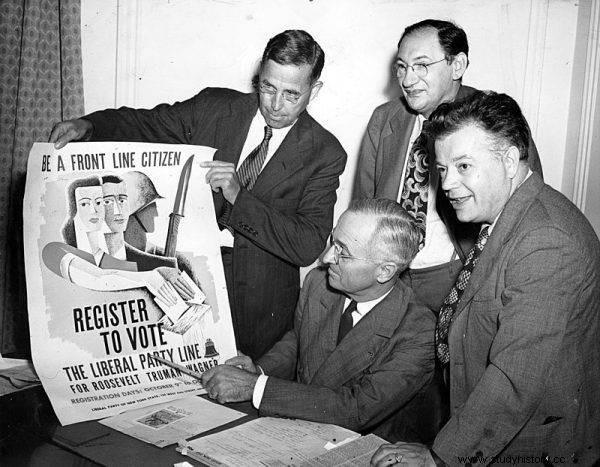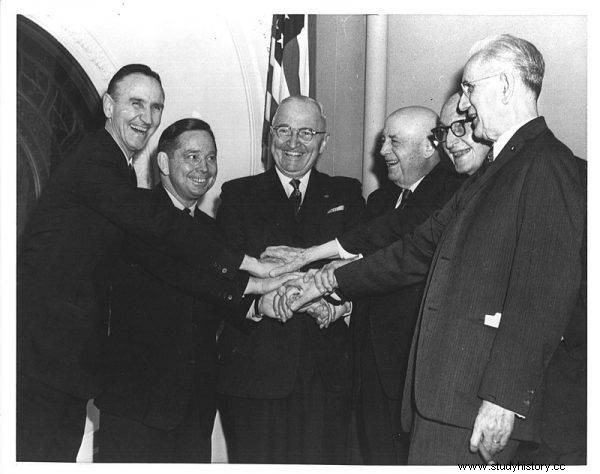Rivalry with the USSR forced the USA to change its foreign policy. On March 12, 1947, Harry Truman introduced a new program to end isolationism.
During World War II, the United States and the Soviet Union were difficult but still allies. With the final defeat of the Third Reich, the situation changed dramatically. In the US, it was increasingly realized that rivalry between the two countries is inevitable and it will be necessary to shift American policy to other tracks. The Truman Doctrine in this context became the swallow which this time spring.
Long Telegram
Already shortly after the end of World War II, the need to change the current US policy became more and more evident. Above all, towards the Soviet Union. It was increasingly understood that further political expansion of the USSR could even threaten American interests. Concrete steps have even been taken in this direction. A thread worth mentioning is the US activity to withdraw Soviet troops from Iran. This led to the end of the conflict that lasted from November 1945 to June 1946. The attitude of the United States was, in a sense, an opposition to the USSR's policy of fait accompli.
However, a specific impulse was needed. And this impulse was delivered by a message prepared and sent by an employee of the US Embassy in Moscow, diplomat George Kennan, to the then Secretary of State George Marshall. (It was after him that the Marshall Plan was later named.) This message, posted on February 22, 1946, is known as the "long telegram" .

This message, posted on February 22, 1946, is known as the "long telegram".
It could be said that George Kennan opened the eyes of the Washington administration a little to the real attitude and goals of the USSR. He suggested that since the Soviet Union would still feel encircled by capitalist states and felt threatened, it would not be possible to achieve long-term peaceful coexistence with it. The same George Kennan in an anonymous article The Sources of Soviet Conduct , published in Foreign Affairs in July 1947, laid the foundations for the later doctrine of containment. He postulated that the policy of containment should be a confrontation with "appropriate forces" with the Soviet Union wherever it shows a desire to infringe the interests of a peaceful and stable world.
Prelude to the doctrine of containment
The modes of the American administration began to work. The telegram was developed in the form of a State Department memorandum by Harrison Freeman Matthews. The inter-ministerial committee received them on April 1, 1946.
Much more important, and at the same time secret, was the report of September 24, 1946, prepared by President Harry Truman Clark Clifford's advisor . The conclusion resulting from both documents was unequivocal . If diplomatic measures against the USSR fail, military force may be necessary. Such language is the only one that power politics students understand . On the other hand, it was understood that in order to stop the expansion of the Soviet Union, it would be necessary - especially towards European countries - to provide them with adequate economic support.
The case of Greece and Turkey
In fact, economic aid was soon to be needed in the Mediterranean. This is because Great Britain was forced to withdraw from supporting Greece and Turkey. She had to deal with the consequences of World War II on her own. In the USA, it was judged that in such a situation, in a weaker Greece, the communists could triumph. This could cause this "infection" to spread to other countries in Europe and the Middle East, including Turkey. It was the so-called domino theory, whose supporter was, among others Undersecretary of State Dean Acheson. In February 1947 he stated that:
The victory of communism in Greece, Turkey, Iran or any other Middle Eastern or Mediterranean country could lead to the rapid collapse of pro-Western governments across Europe. Russian control of ¾ the world's surface and ¾ the world's population would be a real threat to America .

During World War II, the United States and the Soviet Union were difficult but still allies
The US involvement in aid for Greece and Turkey was therefore in the interest of American security. A year earlier, on February 27, 1946, during a meeting between President Harry Truman, Secretary of State George Marshall and Undersecretary of State Dean Acheson with representatives of Congress, it was stated that the world was dominated by two powers . This polarization has not taken place since the days of Athens and Sparta or Rome and Carthage. The extent to which the threat posed by the USSR was considered real is shown in the report of the National Security Council approved by President Truman on November 24, 1948. According to this document, the Soviet Union had the capacity to take over continental Europe and the Middle East as far as Cairo within 6 months.
Birth of the Truman Doctrine
Harry Truman decided that the United States should fill the gap left by Great Britain's withdrawal. He asked Congress to grant both countries $ 400 million in aid. On March 12, 1947, he delivered the message in which he compared this situation to the support provided by the United States during World War II, which was a kind of investment in peace. Interestingly, did not literally mention the Soviet Union. He stated that it was a question of rivalry between democracy and totalitarianism . He also mentioned that the US should: support free nations that resist attempts at their conquest by armed minorities or external pressure .

Harry Truman decided that the gap created after the withdrawal of Great Britain should be filled by the United States.
The US president's thinking was justified. In a situation where Greece, and then probably also Turkey, were in the sphere of influence of the USSR, it would gain free access to the Mediterranean basin. As an example of what could have happened had no firm action been taken, Truman indicated the imposition of totalitarian regimes on Central and Eastern European states such as Poland, Romania and Bulgaria . At the same time - as it seems - no possibility of counteracting this expansion of the USSR in our part of Europe was seen at that time.
Consequences of the new policy
The Truman Doctrine de facto led to the recognition of the Middle East as a region of strategic importance to US interests. In this context, can be compared to the much later Carter doctrine but the latter was more radical. The Truman Doctrine broke with the US isolationist policy (with the Monroe doctrine) because the United States was to be actively involved in activities in Europe. And not in an emergency such as the two world wars. For this reason this doctrine has been criticized even in the US .

The Truman Doctrine broke with the US isolationist policy (with the Monroe Doctrine) as the US was to be actively involved in activities in Europe.
It started with aid given to Greece and Turkey. In the following years, American activities covered a much larger number of countries. An inherent element of the Truman administration's policy of those years was, of course, the plan for the economic reconstruction of Europe - the Marshall Plan . His goal was also to stop the expansion of communism in Western Europe. It was already clear then that due to pressure from the USSR, it would not be possible to extend it to the countries of Central and Eastern Europe.
The reaction of the Soviet Union
Both this plan and the doctrine of Truman itself were eminently out of order for the Soviet Union. And above all, to Joseph Stalin and his plans for Europe. The new US policy posed a real threat to them. Therefore, attempts were made to derail the integration processes taking place in Western Europe. There were even attempts to involve communists from France and Italy. Kominform has been created . The Truman Doctrine has been ruthlessly attacked. It was claimed to be an attempt to start a war with the Soviet Union . After initial interest was expressed, the Marshall Plan was also attacked. According to the USSR, it was supposed to be an element of the implementation of the doctrine. The Soviet press was even aggressive ad personam to President Truman.
Such a nervous reaction from the leadership of the Soviet Union only showed that Harry Truman, by radically changing the US approach to European politics, hit the nail on the head . Throughout the decades of the Cold War, the United States managed to contain the expansionist tendencies of the USSR. And most importantly:this strategy can be re-applied.
